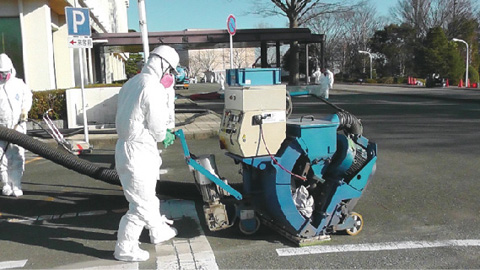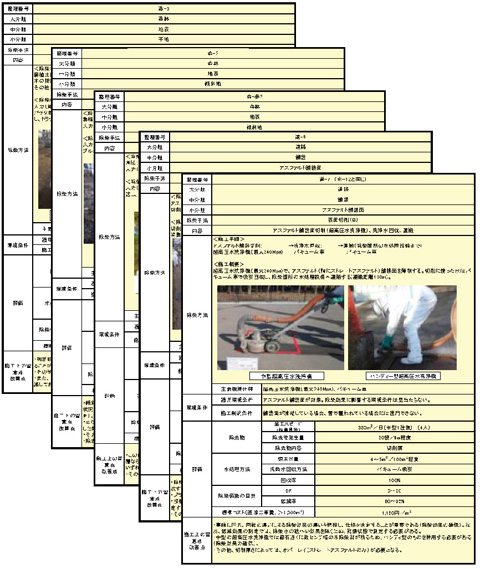
Fig.1-15 Shot blasting
(the Okuma town government office area)

Fig.1-16 Guide to decontamination work
(extract from the report)
The central government and local authorities of Japan have been planning and undertaking decontamination to ensure remediation of environments contaminated with radioactivity after the accident at the TEPCO’s Fukushima Daiichi NPS. For this unprecedented environmental pollution in Japan, guidelines for swift and effective decontamination are required to provide technical information that describes how to perform a series of decontamination processes including dose rate measurement, removal of contaminated soil, cleanup of roads and buildings, safe storage of wastes generated, and protection of workers from radiation. We, under contract with the government, were in charge of the decontamination pilot project for this purpose in 11 cities, towns, and villages within the restricted area (i.e., areas with annual dose rate >20 mSv) and planned evacuation area. The area of the project sites totaled to more than 200 ha. The obtained data were analyzed and interpreted, and the related documents were filed at the end of June, 2012.
A variety of existing techniques were applied in the pilot project depending on the materials to be decontaminated (buildings, farmland, road, forest), the topography, and the structure. The applicability of the techniques employed was evaluated in terms of cleanup efficiency (speed, time required), waste treatment (volume of waste generated by cleanup, recovery of used water), and effectiveness (dose rate reduction, decontamination factors) (Fig.1-15, Fig.1-16).
We introduced a computer simulation system known as the Calculation System for Decontamination Effect (CDE), which calculates dose rates of the area of interest on the basis of the surface contamination density. Therefore, CDE can be used to predict dose rates after decontamination for given values of decontamination factor; in other words, CDE provides information for decontamination planning, such as indicating the amounts of decontamination factor required for certain areas. The applicability of the system was demonstrated in our pilot project, indicating that CDE could be a potent tool for decontamination planning. CDE was developed by JAEA and can be downloaded from the JAEA website (Topic 1-12).
As part of the decontamination pilot project, we designed and constructed temporary storage structures for waste generated by decontamination. The topography of the site, isolation with impervious sheets, and radiation shielding with sandbags were taken into account in the design, in addition to the configuration or positioning of combustible/noncombustible wastes. We conducted periodic inspection to confirm normal function; this involved measuring radiocesium concentrations in leachate tanks, surrounding dose rates, and temperature.
The results of our pilot project were reported at the progress debrief session in Fukushima City on March 26, 2012 (Reference). The pilot project was finished at the end of June. Slides from the presentation at the March 26 session as well as the final documents are available from JAEA’s homepage.
This work was commissioned by the Cabinet Office, Government of Japan.